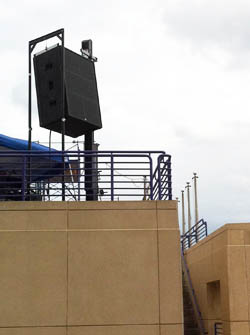
Ryan Field is home to the Northwestern University Wildcats football team and, despite the team’s underdog reputation, the stadium is usually filled to a capacity crowd of over 47,000 fans.
The team and the stadium are steeped in tradition – quite similar to the Chicago Cubs and Wrigley Field. Founding member of the Midwest’s celebrated Big Ten Conference.
The university completed Ryan Field in 1926, making it one of the oldest college football stadiums still in use. Though not quite so old, Ryan Field’s PA system is well into its third decade and exhibits a severely truncated low end and high end. School officials recently hired TC Furlong Inc. to bring Ryan Field’s music reproduction into the 21st Century.
Now, for every home game, TC Furlong temporarily installs just two Danley Jericho Horns to cover all 47,000 seats.
The most obvious failing in the stadium’s old and heavily patched horn-driven system is a lack of bass. It cuts off around 250 Hz. “You can crank Metallica through that system, but it doesn’t sound tough,” commented company president TC Furlong.
“It only gives you the idea of toughness, which is a very different, and much less inspiring, thing. The folks in charge of athletics marketing recognized that this needed to change, so they contacted us. In a word, we promised to give them a solution that would be impactful.”
Furlong and the company’s senior audio technician Scott Helmke had to jump a few logistical hurdles to make that happen. First, because the existing system was still functioning and well maintained, the university was looking for a solution that could be carted in and out only for football games.
Second, rigging options were limited. Those constraints, combined with the need to still deliver sound that would be more than merely adequate (after all, the stadium already has adequate sound!) caused Furlong and Helmke to look into Danley’s new point-source solution for high SPL situations, the Jericho Horn.
The Jericho Horn combines six 18-inch low-frequency drivers, six 6-inch mid-frequency drivers, and three 4-inch two-way high-frequency drivers using a number of Danley’s proprietary and patented technologies. The end result is point source behavior with exceptional phase coherence, pattern control, and fidelity.
After a demo, Northwestern signed a multi-year contract with TC Furlong Inc. Now, a crew arrives at 6:00am on game day, mounts two Jericho Horns on a rooftop terrace, rolls out a pair of processing and amplifier racks, and ties the temporary system into the stadium’s existing infrastructure using both wired and wireless technologies.
Because the Jericho Horns are so powerful, Furlong and Helmke decided to cross their patterns, such that the horn mounted on the east side of Ryan Field covers the fans on the west side of the stadium, and vice versa. Each equipment rack contains an XTA DP226 processor and five dual-channel Crown MA3600 amplifiers. A single Socapex connection links each amp rack to a Jericho Horn.
“The fans get a much better experience with the Jericho Horns,” said Furlong. “And the players do too! The first time we brought the system out, the players got very excited about having a giant, full-frequency stereo in their stadium.”
“Honestly, I think they played with greater intensity.” Although the plan was originally to continue using the existing system for spoken word, everyone agreed that the Jericho Horns would do a better job with spoken word as well. Now, everything is routed through the Jericho Horns.
“Wind can wreck havoc with a multi-point source, such as a line array,” said Furlong. “Because wind is necessarily turbulent, it affects different point sources differently, which effectively destroys the pattern control of a line array. That’s bad for both coverage and frequency response.”
“In contrast, a Jericho Horn is a point-source unit. Even though the wind can affect it, there is no interaction. As a result, the coverage and frequency response of a Jericho Horn is excellent, even on a very windy day.” And of course, Northwestern is right next to the Windy City!
“With exposure targeting, it’s kind of like we have decibels in the bank,” explained Furlong. “If we come to the end of a game and find that we have very few decibels left in the bank, we can keep the level below the prescribed target level for everyone’s safety. But if we have some decibels “credit” we know that we can safely end the game with a bang, so to speak.”
